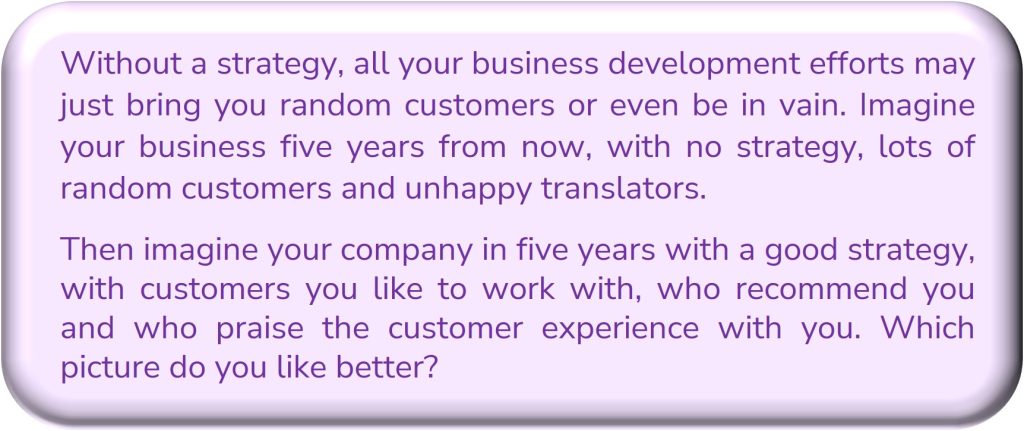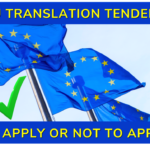
Random or perfect-fit customers?
Growth Strategy
It is not uncommon for translation and localization companies to work sporadically and spontaneously for multiple clients from different industries, with very different areas of expertise and a very specific style. Often, providers of translation and localization services are recommended by someone in their network or random clients spontaneously find them through their website or other marketing resources.
Every bad situation will have something positive
The concept of working with extremely different random clients may work for a while. It ‘pushes’ translation and localization companies to develop and strengthen their adaptability to:
■ new translation areas, translations tools and specific requirements,
■ general business flexibility,
■ resilience,
■ multidisciplinary approach.
Nevertheless, in the long run, not having perfect-fit customers can be quite costly as managing and coordinating multitude of different types of projects requires plenty of time and energy both on the project management and translator team part.
Uphill battle with a myriad of workflows
Therefore, automating and optimizing translation workflows efficiently and effectively can be a difficult task. One translation company may work mainly with large corporate clients from IT or the pharmaceutical industry, the other with EU institutions, the third with certified translations and subtitles. In such scenarios, random clients mean:
■ a whole new set-up of projects,
■ style guides,
■ internal steps,
■ team alignments, and the like.
This may happen frequently for just a few translated pages and even without the potential for a long-term relationship. Sometimes it’s an uphill battle.
Switching translation styles is frustrating and time-consuming
Also, translators get frustrated because they must constantly switch from one style to another, which can severely impact their productivity. A translator who has worked on medical and pharmaceutical content for a few years cannot, in the blink of an eye, switch to a marketing text about water pumps or wheat harvesters. It takes a lot of time and energy to get familiar with the new area of expertise, terminology, style, and other specifics.
And time is the most valuable resource a company can have.
Furthermore, this is also a problem for similar professional services such as:
■ legal services,
■ financial and accounting services,
■ small and medium IT businesses, etc.
A growth strategy as one of potential solutions
The solutions here can be:
■ defined ideal buyer personas,
■ well-thought-out marketing efforts,
■ well-formulated growth strategy.
In this way, you have a clear plan how to reach and retain your ideal clients who resonate with your specializations, communication style and tone, beliefs, and values. The above-mentioned solutions help you to find the perfect fit for your business model so that both your customers and you are truly satisfied with the collaboration. Satisfaction is the key here as:
■ you will be doing what you really know and like,
■ you will know that you really deliver value,
■ you will feel good in interactions with your clients,
■ you will be really fulfilled and motivated,
■ people around will enjoy the energy you exude.
Create your business evangelists
On the other hand, satisfied clients will ideally remember the good customer experience, enjoy interacting with you and gladly ask for more, and finally will recommend you further – they will be your business evangelists. And being recommended in business is one of the most efficient marketing efforts.
Don’t be like Alice
This reminds of the situation in Lewis Carol’s Alice in Wonderland: one day Alice came to a fork in the road and saw a Cheshire Cat in a tree. ‘Which way do you want me to go?” she asked. ‘Which way do you want to go?” was his reply. ‘I do not know,’ Alice answered. ‘Then,’ said the cat, ‘it does not matter.
■ So, do you know which way your company is going?
■ Do you know who you want to work with in terms of customers, suppliers, and employees?
■ Do you want to steer the boat for the future of your business?
■ Do you know how much revenue you want to generate in the next 5 years?
If you are not quite sure, Profecta BDI can help you find the answers and guide you on your way as a coach, accountability partner, business development support, and neutral observer. The discussion about the importance of having a strategy will continue on our blog, so stay tuned.
And, if you want to learn more about how to sell your translation services in 2023, please reserve your spot now and register for our webinar: Sell Your Translation Services Like Hot Cakes Through Calls and Emails.
Wishing you as many ideal clients as you want!









